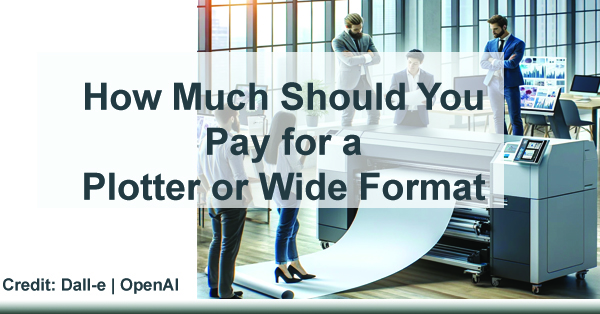
How much is a plotter printer? | Authorized Plotter Dealership
Today’s world is visual! High-quality, large-scale prints are more crucial than ever, whether for architectural blueprints, marketing banners, or stunning art reproductions. Businesses contemplating an investment in a plotter or wide format printer often find themselves navigating a complex market filled with a variety of options.
This blog aims to demystify the costs associated with these printers, explain the differences between plotters and wide format printers, highlight top manufacturers including Roland, and delve into the specifications you should consider before making a purchase.
Understanding the Difference: Plotter vs. Wide Format Printer
While some find the differences obvious, we don’t want to assume that everyone knows. Distinctions are in order. The terms “plotter” and “wide format printer” are often used interchangeably, but there are distinct differences between the two:
- Plotters: Traditionally, plotters are used primarily for vector graphics. They are the go-to choice for applications requiring precise line quality and accuracy, such as engineering drawings or architectural plans. Plotters use a pen or a blade to draw on the surface, making them ideal for producing technical drawings and CAD designs.
- Wide Format Printers: Unlike plotters, wide format printers are capable of printing on larger scales and a variety of materials, including vinyl and fabric. They use inkjet technology to produce rich, detailed graphics suitable for banners, posters, wallpapers, and more. These printers are preferred for graphic arts and commercial printing due to their versatility and ability to handle color-intensive applications.
How Much Should Do Plotters and Wide Format Printers Cost?
Cost Factors: The price of plotters and wide format printers can vary significantly based on several factors:
- Functionality: Devices that offer multifunction capabilities (e.g., scanning, cutting, and additional finishing options) will cost more than those with simple print functions.
- Print Quality and Speed: Higher resolution and faster printing speeds increase the printer’s price.
- Brand and Model: Established brands often charge more, but also offer better reliability and after-sales support.
- Ink Type and Consumption: Printers that use less expensive inks or have more efficient ink usage can reduce overall operating costs, despite a higher initial price.
Price Range:
- Entry-level wide format printers can start as low as $3,000, suitable for small businesses or low-volume needs.
- Mid-range models typically range from $10,000 to $20,000, offering better speed and resolution, suitable for medium-sized businesses.
- High-end models, particularly those designed for high volume and optimal performance, can go upwards of $30,000.
Related Post: Unraveling the World of Plotter printing | A Beginner’s Guide & HP Plotters vs Canon Plotters
Top Manufacturers and Why Roland Stands Out
When shopping for plotters and wide format printers, it’s critical to consider manufacturers that not only provide quality machinery but also encompass reliability, support, and technological innovation. Some of the top names in the industry include:
- HP: Known for their robust technology and excellent image quality, HP offers a range of printers that suit both high-volume industrial printing and finer, detailed graphic work.
- Canon: With a focus on photographic print quality, Canon printers are favored for their superior color accuracy and gradation.
- Epson: Epson printers are widely appreciated for their advanced inkjet technology and high-resolution outputs, making them suitable for detailed artworks.
- Roland: Roland stands out particularly in the realm of versatility and durability. Roland printers, such as the TrueVIS and VersaEXPRESS series, are celebrated for their exceptional color quality and eco-friendly printing solutions. They offer a broad range of applications, from sign making to textile printing, and feature cutting-edge technology that ensures longevity and precision.
(*Fun Fact: ABT is now a Roland Printer and Supplies Dealer – sign up for more information in the chat!)
| Manufacturer | Model | MSRP | Primary Use Case | Industry Use |
| Roland | TrueVIS VG2-640 | $18,995 | Versatile graphic printing | Signage, Vehicle Wraps, Fine Art |
| HP | DesignJet T730 | $2,995 | Technical and CAD drawings | Architecture, Engineering, Construction |
| Canon | imagePROGRAF TA-30 | $3,995 | High-quality poster printing | Retail, Education, Marketing |
| Epson | SureColor T5170 | $2,195 | Precision line drawings | Architecture, Engineering, Design |
| Roland | VersaEXPRESS RF-640 | $14,995 | High-speed banner printing | Outdoor Advertising, Retail |
| HP | Latex 365 | $15,995 | High-volume, eco-friendly printing | Retail, Hospitality, Healthcare |
| Canon | PRO-2000 | $2,995 | Professional photo prints | Photography, Fine Art, Proofing |
| Epson | SureColor F6370 | $8,495 | Dye-sublimation printing | Textiles, Fashion, Merchandise |
| Roland | SOLJET EJ-640 | $29,995 | Industrial-strength printing | Banners, Billboards, Fleet Graphics |
Key Takeaways from the Table:
- Price Range: The table shows a wide range of prices, reflecting different capabilities and target uses. Entry-level models like the Canon imagePROGRAF TA-30 are more affordable for small businesses and schools, while high-end models like the Roland SOLJET EJ-640 cater to high-volume, industrial printing needs.
- Use Case: Each printer has been optimized for specific tasks. For example, HP’s DesignJet series is renowned for precise technical drawings, making it ideal for engineering or architectural work, whereas Epson’s SureColor F6370 is designed for soft goods and textiles, indicating a strong presence in the fashion industry.
- Industry Applications: The industry use column helps potential buyers understand where each model can be best utilized. For instance, printers like the HP Latex 365 are highlighted for their eco-friendly printing capabilities, making them suitable for environments where health and environmental standards are crucial, such as in hospitals or schools.
Exploring Plotter Leasing Options
For many businesses, purchasing a high-end plotter or wide format printer outright can be a significant financial burden, especially for startups or those looking to conserve capital for other investments. Leasing a plotter presents a viable alternative, allowing you to utilize the latest technology without the upfront cost of buying new equipment.
When exploring plotter leasing options, it’s essential to consider a few key factors to ensure you find a deal that best suits your business needs.
Key Considerations for Leasing:
- Lease Terms: Understand the length of the lease and what happens at the end of the term. Some leases offer the option to buy the equipment at a reduced price, return it, or upgrade to a newer model.
- Monthly Costs: Evaluate the monthly lease payments to ensure they fit within your budget. Also, consider any additional costs such as maintenance, supplies, and insurance that may be required under the lease.
- Maintenance and Support: Check if the lease includes servicing and maintenance. Regular maintenance can significantly extend the life of a printer and improve its performance, so a lease that includes comprehensive servicing can provide added value.
- Upgrades and Flexibility: Technology evolves rapidly, and leasing can offer the flexibility to upgrade to newer models more frequently than purchasing. Ensure your lease agreement allows for upgrades without penalizing you financially.
Leasing can also offer tax advantages, as lease payments can often be deducted as business expenses, reducing the net cost of your lease. Before committing to a lease, it’s wise to shop around and compare offers from multiple vendors. Ensure you understand all the terms and conditions to avoid unexpected costs and to maximize the potential benefits to your business.
Partnering with reputable vendors who offer transparent terms and solid customer support, such as those producing Roland printers, can further enhance the leasing experience, providing peace of mind and ensuring that your business’s printing capabilities keep pace with industry standards.
Key Specifications to Consider
Before committing to a purchase, consider these specifications to ensure you choose the right printer for your needs:
- Resolution: Higher resolution is crucial for detailed graphic work.
- Media Handling: Look for printers that can accommodate various media types and sizes, especially if you require flexibility in your print jobs.
- Connectivity Options: Ensure the printer supports various connectivity options like USB, Ethernet, and Wi-Fi for easier operation.
- Software Compatibility: Check that the printer is compatible with the software you plan to use, such as CAD applications or graphic design software.
Investing in a plotter or wide format printer is a significant decision that can impact your business’s capability to produce high-quality work efficiently. By understanding the differences between plotters and wide format printers, considering the costs, and evaluating the offerings from top manufacturers like Roland, you can make an informed choice that matches your business’s specific printing needs and budget. Remember, the right printer isn’t just about the price—it’s about the value it adds to your work.
